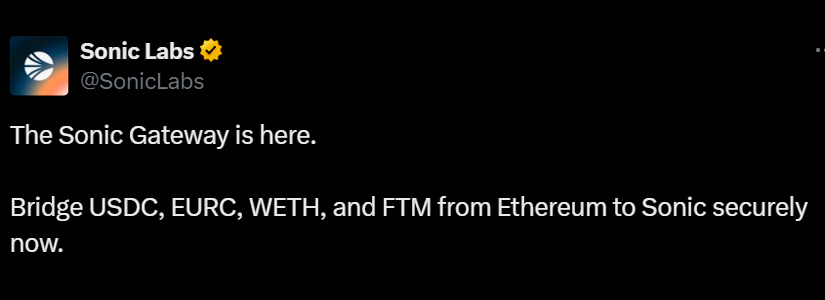TL;DR
- Sonic Labs has launched the Sonic Gateway, facilitating seamless token transfers between the Ethereum network and the Sonic blockchain.
- The Sonic Gateway supports various tokens, including FTM, EURC, USDC, and WETH, with robust security measures and efficient transaction processing.
- This launch marks a significant milestone for Sonic Labs, attracting more users and developers to its ecosystem and opening new possibilities for DeFi, NFTs, and other blockchain applications.
Sonic Labs has announced a significant advancement in cross-chain integration with the launch of its Sonic Gateway. This innovative bridge facilitates seamless token transfers between the Ethereum network and the Sonic blockchain, enhancing interoperability and expanding the utility of both platforms.
The Sonic Gateway aims to provide a secure, efficient, and decentralized solution for cross-chain transactions, addressing the growing demand for interoperability in the blockchain ecosystem.
Key Features of Sonic Gateway
The Sonic Gateway supports the transfer of various tokens, including FTM, Euro Coin (EURC), USD Coin (USDC), and Wrapped Ethereum (WETH), between Ethereum and Sonic.
The conversion of FTM to Sonic’s native S token occurs at a 1:1 ratio, ensuring a straightforward and transparent process for users. Sonic, a new blockchain compatible with the Ethereum Virtual Machine, was launched on December 13 and is designed to process up to 10,000 transactions per second with block finality in less than one second.
Security and Efficiency

One of the standout features of the Sonic Gateway is its robust security measures. The gateway relies on network validators who run both the Sonic client and Ethereum’s Light Client to validate transactions and maintain security.
Additionally, the Sonic Gateway includes a fail-safe mechanism that allows users to recover bridged assets on Ethereum if the gateway is non-functional for more than 14 days. This ensures that asset custody remains accessible even in extreme circumstances.
The Sonic Gateway also prioritizes efficiency by processing transactions in intervals called “heartbeats.” These heartbeats occur every 10 minutes from Ethereum to Sonic and every hour from Sonic to Ethereum, bundling transactions to save on gas costs.
Users who require immediate transaction processing can pay a fee via the Fast Lane, which accelerates their transactions and processes queued assets instantly.
Market Impact and Future Prospects
The launch of the Sonic Gateway marks a significant milestone for Sonic Labs and the broader blockchain community. By enabling secure and efficient cross-chain transfers, Sonic Labs is poised to attract more users and developers to its ecosystem.
The gateway’s ability to bridge assets between Ethereum and Sonic opens up new possibilities for decentralized finance (DeFi), non-fungible tokens (NFTs), and other blockchain applications.
